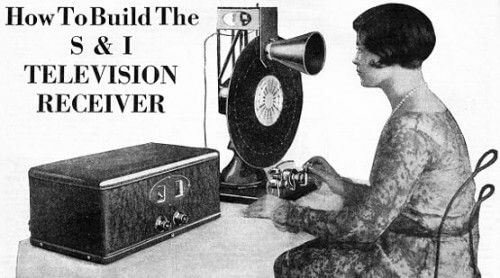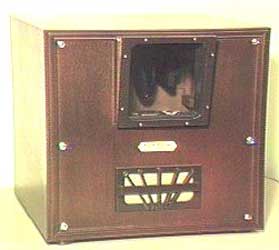On March 25, 1925, the Scottish inventor John Logie Baird projected a video consisting of moving silhouettes in the Selfridges department store in London using a mechanical television receiver and transmitter. The BBC in Great Britain dozens of stations in the USA, Europe and even the Soviet Union broadcast mechanical television broadcasts, before the technology gave way to CRT

Today, when we are able to watch thousands of channels in any given area via satellites or live broadcasts on the Internet, it is difficult for us to describe what this wonder looked like in its early days. Every now and then we see in old movies or ones that take place in the XNUMXs, a family sits by a large television set, with a small screen in the center and watches some soap opera. But it turns out that it was already an advanced generation, which used a cathode ray tube (CRT) not to mention today's televisions that use LCD or LED screens to create and project the image.
according to Wikipedia, attempts at mechanical transmission and reception of signals were made throughout the 19th century and increased in the 20th century.
On March 25, 1925, Scottish inventor John Logie Baird projected a video consisting of moving silhouettes at the Selfridges department store in London. Since human faces did not have sufficient contrast to be seen in the primitive system, he introduced a talking and moving wooden doll called "Stooky Bill", whose painted face had stronger contrast.
On January 26, 1926, he demonstrated the first transmission of a human face in motion via radio, which is now considered the first television transmission. Byard's system made use of Nipkov discs both for scanning the image and for displaying it.
How exactly did the mechanical television work?
Mechanical televisions used a spinning disc in the transmitter and receiver. This disk contained holes that were scattered around the disk, and each hole was slightly lower than the previous one.
The camera is set up in a completely dark room. A very bright light was placed behind the disc. The disk was rotated by means of a motor and could make one revolution in each frame of the television picture. In the standard developed by Baird (Baird standard), the disc contained three holes and rotated 12.5 times per second. A lens placed in front of the disk focused the light on the imaged object.
When the light hit the bone, it was reflected into a photoelectric cell, which converted the light energy into electrical impulses. Dark areas actually reflected little light, and only a small amount of electrical impulse was generated, while light areas actually reflected more light, and therefore generated more electrical impulse.
These electrical impulses were amplified and transmitted through the air to the receiver, which also had a disk that rotated by means of a motor, and which moved at exactly the same speed as the disk in the camera. The developers used several methods to synchronize the motors.
A radio receiver picked up the video signals and transmitted them to the neon light placed behind the disc. When the disc rotated, the neon light emitted light according to the strength of the electrical signals it received from the redo receiver. For dark areas a little light was projected, in bright areas a stronger light was projected. The image was seen on the other side of the disc, usually with the help of a magnifying glass.
At the same time as Baird, once in the USA also Charles Francis Jennix who developed competing mechanical devices. The first broadcasts in the USA were on AM frequencies (550-1,500 kHz). In 1930, the Federal Radio Commission allocated 2 MHz channels to experimental television broadcasts with the aim of enabling higher resolution broadcasts (45 and 60 picture lines).
The image quality was poor, and the screens, with a diameter of a few centimeters, were only able to project 30-60 lines (compared to 525 in the current American system). Most receivers used a motor to rotate the metal disc and produced an image using fluorescent tubes. Later systems used a screw-type mirror, a drum mirror, and lens discs. The Scophony system was the only method that enabled high-resolution images, but it was developed at a time when the cathode ray tube had already been proven to be a better method for displaying television images.

In 1931, television broadcasts were already broadcast on 25 stations in the USA, not only in big cities such as New York and Boston, but also in Iowa and Kansas. Some of the manufacturers even marketed devices and kits for self-assembly. The frequency used for the television broadcasts could travel long distances, so that they could be received hundreds of kilometers from the station, but the image suffered not only from low resolution but also from sudden weaknesses and disappearances.
In Britain, regular programs were broadcast on 30-line televisions. The first broadcast was by the BBC in September 1929 and also used equipment supplied by Baird. Initially Vedra only shot a picture for a few hours a week and that too after the end of the radio broadcasts that day. Until March 1930, picture and sound were broadcast together. In 1933, Byard built a studio in Crystal Palace in London. In most European countries there was at least one mechanical TV station.
Due to the poor picture quality, the mechanical televisions were not a commercial success. By 1933 most of the stations were off the air in the USA and in 1936 the 2 MHz frequency was transferred to police uses. The BBC's mechanical television broadcasts continued until 1935 and in the Soviet Union - until 1937.
Mechanical scanning systems eventually gave way to electronic scanning technology in the late XNUMXs, and it was this that was used for the first commercial television broadcasts in the late XNUMXs.
For information on the website of the museum of the first televisions
More of the topic in Hayadan:
The effect of lightning on radio reception and its safety - a review of an article from 1936, Aryeh Seter
Radio and electronics in the Land of Israel in the twenties
Radar - an invention without an inventor
